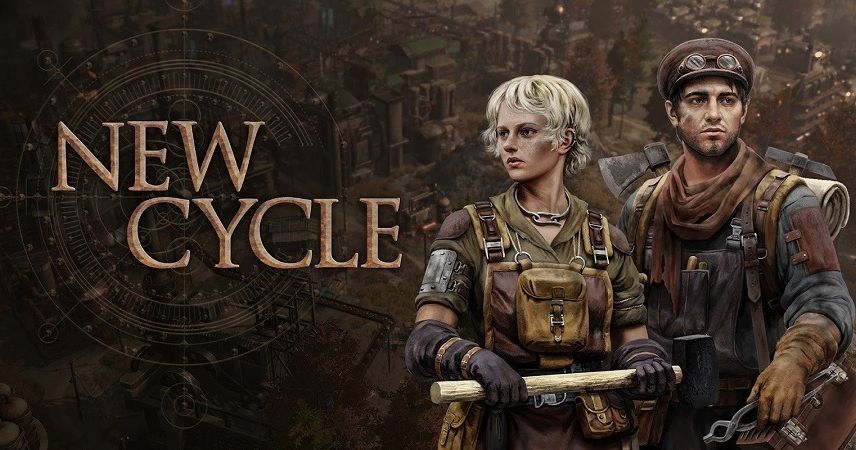Admit it, have you already missed playing games in a post-apocalyptic setting? After all, they haven’t been released on Steam for two whole hours. More often than not, all of these “survivors” appear on the Valve site except hentai puzzles. What does New Cycle have to offer to stand out from the competition in the crowded wasteland of the genre? Let’s find out in this article.
Beware of nature, your mother
This time, the big and terrible end of the world happened due to solar flares, which destroyed all at least some developed technology. Finding ourselves without smartphones, computers and daily news on our beloved Cybersport.ru, humanity quickly became brutal, reduced its own numbers and slipped into the Stone Age.
50 years after the cataclysm, when the last witnesses of likes, TikToks and memes died, we take upon ourselves the leadership of a bunch of nomadic vagabonds who have finally decided to settle down. This is where our urban planning journey begins to create the greatest post-apocalyptic metropolis. Well, or an average lousy village, there’s enough skill for that.
There are two modes in Early Access: sandbox and campaign. In the future, the developers promise to add several more options with different plot and gameplay nuances. The current ones differ in that the campaign provides for scripted cataclysms, including the repeated end of the world.
In general, the above-mentioned cataclysms and nature in general are perhaps the main post-apocalyptic component of New Cycle. There are no zombies, radioactive mutants or endless winter in the game. The developers are just considering the possibility of adding enemies, but until then the only enemy remains nature.
In winter, it prevents food gathering, severely limits work opportunities, and encourages the spread of disease. In the summer, every now and then it strives to destroy buildings by lightning and fires. And in the story mode, every year she wants to kill people more and more. It sounds terrible… Or rather, it would sound if the same thing did not happen every day outside the window of each of us. In other words, the post-apocalypse in New Cycle lacks a zest that would not only make it stand out in the genre, but at least distinguish it from ordinary city builders.
The atmosphere of the end of the world is also undermined by some gameplay elements. While in some conventional “Zombie Dead” people are desperately looking for the latest Twinkies, and communities are struggling to build a single mill, in New Cycle I have a whole field of wind turbines, a coal-fired power plant and a brand new railway. The tension may have been raised by complex moral dilemmas from the “world after the end of mankind and humanity.” But I only came across tasks like “should children be allowed to have cats”, “establish a New Year celebration”, “allocate paper for keeping diaries”, etc.
Because of all this, New Cycle looks more like a steampunk (or even dieselpunk – yes, oil can also be extracted) economic simulator. Not that this is bad – Gabe sees that the post-apocalypse niche is already crowded – but this is how an already not very expressive individuality is lost.
Big brother is watching you. He doesn’t want to, but he has to
The core of New Cycle’s gameplay is developing a settlement for its survival. There is no money here, as usual for economic simulators, but there is plenty of other extracted and produced resources: wood, meat, millet, ore, etc. The main resource is people; once it is exhausted, the game will end.
Our charges do not have individuality, but we still have to babysit them. Remember what you will need: food, clothing, tools, medicine, shelter, entertainment and safety. For most parameters, it is necessary to establish excretion standards, on which morale and health depend. The latter, in turn, directly affect work efficiency (as does the workload norm, which should not be forgotten either), which determines how many resources people will produce.
In addition, people are divided into three classes, for which everything is configured separately, and there are also various modifiers that increase one or another parameter. For example, I, a kind soul, foolishly made a bunch of decisions that increase people’s satisfaction, but reduce employment in production. Because of this, my businesses are in a pre-comatose state. But the workers are still unhappy, because they do not have enough goods that they themselves do not create enough.
Sounds too complicated? Don’t worry, content growth happens gradually. At first you will have only a few people who will collect mushrooms, chop down trees and saw logs. They will then learn to smelt steel, hunt, and build wind turbines to power the brick kiln and forge. A little more time will pass when the surface deposits of stones and ore run out and you begin to build mines. And there it will be possible to launch a power plant, a railway and a conveyor belt, turning the entire city into a huge factory.
Yes, development occurs gradually, but steadily and at an ever-increasing speed. Just like in real life. This is probably the main charm of New Cycle – constant progress, constant changes, the constant need to keep your finger on the pulse. Even if you manage to set up a perfectly functioning system, any little thing can break it, forcing you to react immediately.
Any change in population means that distribution rates need to be reconsidered, as well as jobs and housing need to be taken care of. The depletion of one resource leads to the destruction of the entire chain or several. For example, without coal, a power plant will shut down, without electricity, foundries will shut down, without metal, production in workshops will stall, without tools, the efficiency of workers will decrease, who will bring less food, and in the end everyone will die of hunger.
Resources quickly accumulate in warehouses and can disappear just as quickly if mistakes are made. For example, I forgot that water is consumed not only for watering people themselves, but also for growing plants. After building the farms, I did not bother with the redistribution of water and new wells, so I lost almost all my supplies. And these are just the beginnings, because immediately after this a fire broke out, which there was nothing to extinguish, which is why it began to spread to other buildings. The catch is that, since all the water produced was used to put out the fire, several people died due to its lack, and the morale of the entire population went into the negative, since food production had to be stopped.
The feeling of a crisis constantly breathing in your back is great for an economic simulator, because without problems and risks, all interest would be lost. However, the developers of New Cycle went a little too far with micromanagement. As a result, it turned out that we are not so much keeping our finger on the pulse as we are leading each resident by the hand.
At the initial stages this is not a problem. It’s okay if you need to transfer a couple of people from mushroom picking to the sawmill. But if you have more than a hundred employees and dozens of production facilities, keeping track of all this is very stressful. We must constantly keep in mind how many people are engaged in seasonal work, how many resources are being extracted that have reached the limit, where is the occupancy rate, which enterprises use which resources and in what volumes, and so on. And then you need to manually adjust all this.
Yes, there are tables and graphs, but you can’t control the game through them, and they don’t provide enough information. Because of this, in the second half of the game you have to either endlessly run around the map or just score. I have come to terms with the fact that my people continue to work on farms in the winter and mine iron, which has nowhere to go.
Unexpected Early Access Surprise
New Cycle has just been released in early access; there are still about two years left until the full release, according to the information on Steam. During this time, the developers promise to add new modes, biomes, gameplay mechanics, models, etc. But the game can surprise you with something right now: it works stably.
I can’t believe that I’m focusing on this, but lately there have been so many crude (and, by the way, AAA) releases that you perceive the banal absence of a ton of bugs with aspiration. Of course, they exist; we would be much better without them. The music disappeared once, income/expense indicators are periodically displayed incorrectly, some buildings can malfunction, which is why they have to be demolished. But overall it works pretty well.
The picture may not seem particularly graphic, but it is quite pleasant. Especially in the dynamics: the fire is burning, little people are running back and forth, buildings are changing, the rain is falling very strangely, but it is raining. At this point I was going to say that for a game at a modest price tag this is very good, but I don’t know the price yet.
New Cycle is a promising city-building simulator that fans of the genre should keep in mind. The key gameplay mechanics work well, gradually revealing deeper and more complex aspects of the gameplay. New Cycle has two main problems. Firstly, the abundance of micromanagement spoils the impression of the later stages of the game. Secondly, the new product lacks individuality, something that would set it apart from its competitors. Let’s be honest, the text above applies to many, many titles. I hope the developers will have time to make the game unique before release.


